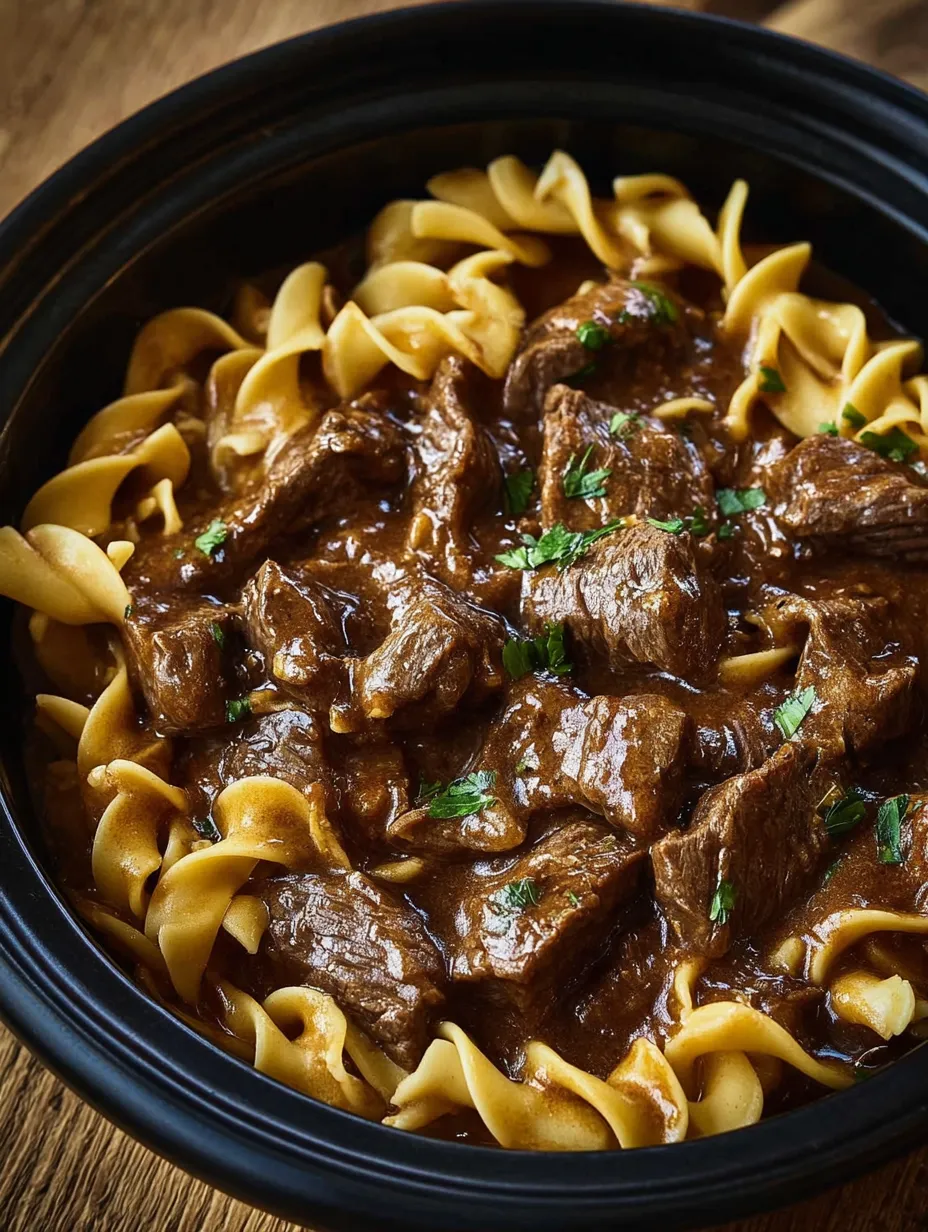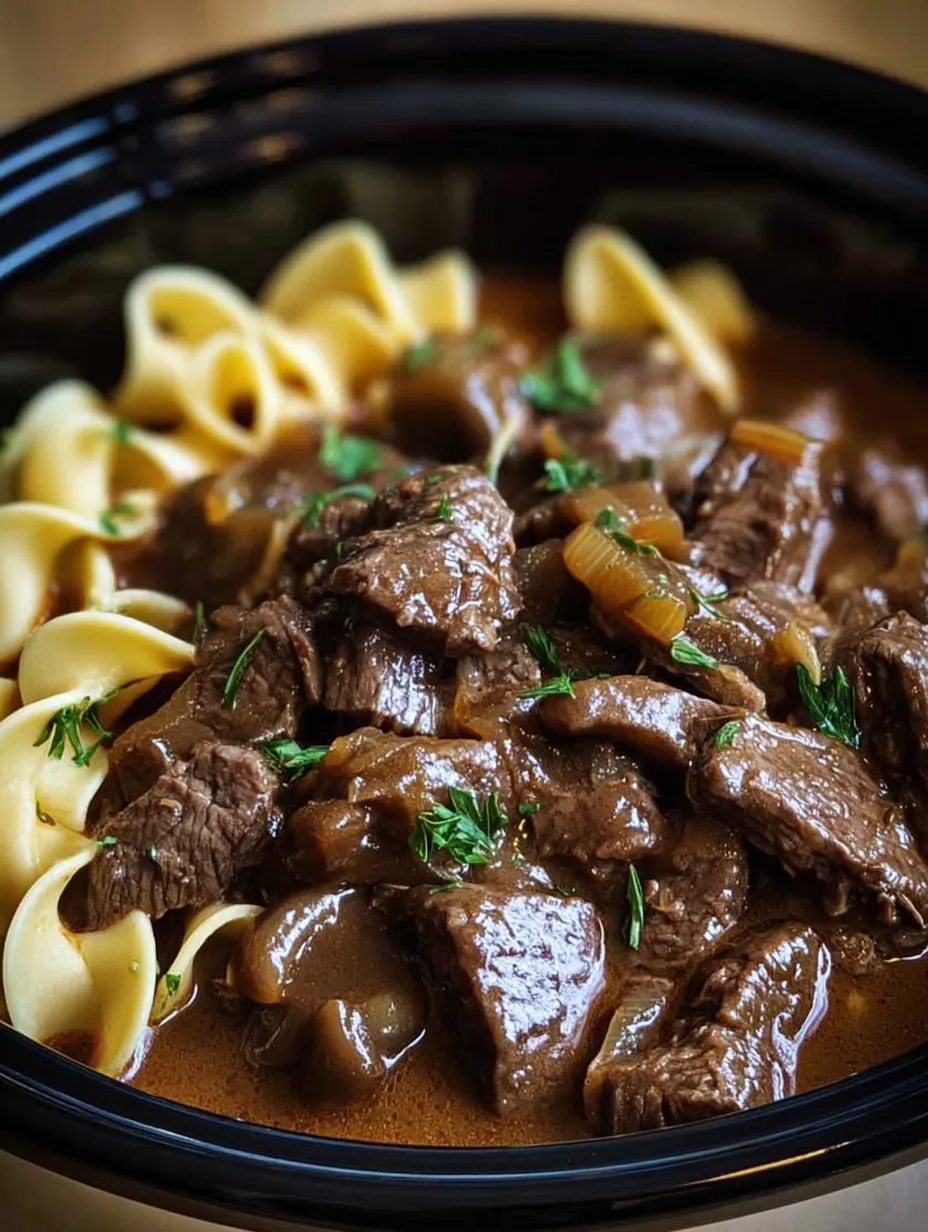 Save
Save
The slow simmer of beef and mushrooms mingling with garlic and thyme always reminds me of those cozy winter Sundays at my parents’ house—the kind where the whole family lingered at the table long after plates were cleared. My first attempt at slow cooker beef and noodles happened during a particularly hectic week when I wanted something comforting but hands-off. The way that browned meat deepened in flavor over hours, folding into tender noodles, felt like a small kitchen miracle.
I remember the first time I realized browning the meat beforehand transformed the dish. Skipping that step left the stew flat and pale. Once I added it back in, the whole recipe opened up with a deep, savory richness.
Essential Ingredients
- Beef chuck roast: the right cut for slow braising; look for marbling and firm texture to ensure tenderness and flavor
- Yellow onion: caramelizes beautifully to add sweetness and depth; choose bulbs that are firm without soft spots
- Garlic: wakes up the base with an aromatic punch; fresh cloves are best—avoid shriveled or sprouted ones
- Mushrooms: bring earthiness and umami; baby bellas work great here, and they should be dry and plump, not slimy
- Beef broth: forms the juicy heart of the dish; homemade or a good-quality low-sodium store brand lets you control salt levels
- Wide egg noodles: soak up all those meaty juices; fresh or dried works, but keep them thick and wide for the best texture
- Dried thyme and parsley: classic herbs that layer gentle herbal notes; check for vibrant color and a strong aroma
Don’t be tempted to skip the flour dusting either—it helps thicken the sauce and creates a velvety coating on the beef.
Cooking Process
- Building the Base:
- Patting and tossing the beef cubes in seasoned flour creates a thin crust that locks in moisture and helps develop a rich gravy once slow-cooked.
- The Maillard Magic:
- Browning the meat in batches is worth the extra effort; those golden edges add caramelized complexity no slow cooker alone can replicate.
- Flavor Layering:
- Sautéing onions until golden and adding garlic releases their natural sugars and fragrance, setting a robust foundation before the broth and mushrooms join the mix.
- Gentle Simmer:
- Cooking on high heat for 4 hours turns the beef meltingly tender, allowing flavors to intertwine fully without the risk of drying out.
- Noodle Finish:
- Adding noodles at the end and lowering heat prevents mushiness, letting them absorb the broth while maintaining a satisfying bite.

One time, I overcooked the noodles by leaving them in too long and ended up with a porridge-like texture. Lesson learned: adding them last and gently cooking for just 30 minutes keeps them perfectly al dente.
Make-ahead strategies
This stew freezes beautifully if you leave the noodles out—freeze the beef and broth mixture in airtight containers up to 3 months. When ready to eat, thaw overnight, reheat, then stir in fresh noodles for the final 30 minutes.
Flavor variations
Try swapping mushrooms for roasted root vegetables in fall, or add a splash of red wine during the sautéing stage to ramp up richness. A sprinkle of smoked paprika can add unexpected warmth.
Seasonal adaptations
In spring, toss in fresh peas and chopped spinach with the noodles for a lighter twist. For winter, serve with roasted Brussels sprouts or garlic green beans for extra coziness.
Kitchen tool recommendations
A sturdy slow cooker with programmable heat settings is key for consistent results. A cast-iron skillet makes browning meat effortless and evenly distributes heat. For perfect noodles, a wide slotted spoon helps scoop and serve without breaking.
Cooking Secrets
- Don’t rush the browning step; it’s the flavor anchor of this dish.
- Use homemade or high-quality beef broth—it makes all the difference in depth and body.
- Resist stirring the noodles too often once added to avoid them turning mushy; gentle folding is enough.

Frequently Asked Recipe Questions
- → What cut of beef works best for this dish?
Chuck roast is ideal due to its marbling which breaks down during slow cooking, resulting in tender, flavorful meat.
- → Why is browning the beef important before slow cooking?
Browning seals in juices and adds depth through caramelized flavors, enriching the overall taste of the dish.
- → How can I prevent the noodles from getting too soft?
Adding the wide egg noodles near the end and cooking them on low heat helps maintain a slightly firm, al dente texture.
- → Can this dish be prepared ahead and reheated?
Yes, cooked leftovers keep well refrigerated for 3-4 days. For longer storage, freeze without noodles for up to 3 months.
- → What sides complement slow cooked beef and noodles?
Try pairing with crusty sourdough, simple green salad, roasted Brussels sprouts, or steamed green beans to balance the rich main dish.
- → How do herbs like thyme and parsley enhance the flavor?
Thyme adds earthy warmth simmered into the broth, while fresh parsley brightens and balances richness at the end.
